Published
on 8
Jan 2012
|
All rights reserved. |
|
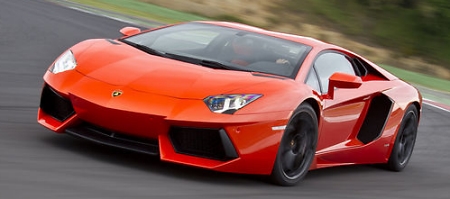 |
|
With
new chassis and engine, big Lambo wants to be back on top.
|
|
A while ago, Evo
magazine
gather Lamborghini Aventador and its ancestors Countach, Diablo and
Murcielago for a comparison drive. While the newest car was found to be
easily the best of the bunch, it was Countach
that impressed most. That
is hardly a surprise to our readers. As we always said, no other
supercars dominated the world longer than the mighty Countach – some 17
years to be exact (1974-1987). Ironically, it was also the last
Lamborghini to be regarded as the world's top supercar. Diablo and
Murcielago did not disappoint, but they just followed the formula set
by Countach and failed to take another leap like that from Miura to
Countach. When new generation super-exotics like Ferrari F40, McLaren
F1 and Bugatti Veyron arrived, the big Lambos became outclassed.
For 37 years since the first LP400 launched, the flagship Lamborghini
did not deviate from the formula of tubular spaceframe chassis,
longitudinally mid-mounted V12 and a gearbox mounted fore of the
engine. Traditionalists might call it the classic formula, but the
spirit of Countach was never about classic. It was all about
innovations and excellence. At that time, tubular spaceframe chassis
was the best possible for road cars in terms of weight and rigidity, so
Giampaolo Dallara decided to adopt it without the slightest hesitation.
Today, carbon-fiber is
the top choice for those really exotic – such as Bugatti, Pagani and
Koenigsegg. If Sant'Agata wants to return to the top league, it has to
switch to carbon-fiber chassis. This is especially true since McLaren
managed to bring carbon-fiber tub to the even cheaper MP4-12C last year.
 |
|
Wedge
profile remains true to Countach
|
|
Another top
priority on
the to-do list is a brand new engine. We are not asking for a downsized
turbocharged motor, as we know for pure driving satisfaction nothing
compares with an Italian naturally aspirated V12. What the Aventador
needs is a clean-sheet V12 rather than another small evolution of the
Bizzarrini-designed unit, whose history could be traced back to half a
century ago to the very first 350GT ! Modern construction is able to
make it lighter, lower, higher revving and more powerful. As the last
one on SV was already good for 670 horses, a full 700 hp shall be the
starting point.
In this way, Aventador LP700-4 was born. Like its ancestors, it is
named after a Spanish fighting bull, and the rest of the name
refers to longitudinal mid-engined, 700 horsepower and 4-wheel drive.
Exterior
The Aventador was designed by the little known Filippo Perini,
Lamborghini's design chief since 2004. Previously responsible for
facelifts like Gallardo Superleggera, LP560-4, Murcielago LP640 and
Reventon, Perini finally got the job that every automotive designer
would dream of: to design a brand new Lamborghini V12 model !
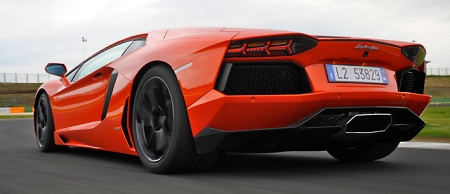 |
|
New
styling attempts to bring back the uncompromising character lost...
|
|
The exterior of
Aventador
is a consistent evolution from the Countach-Diablo-Murcielago
bloodline. Its wedge profile is unchanged, as are the trademark
"scissor doors". However, compare with the refined Murcielago it is
added with an extra sense of aggression. Its nose becomes a knife edge,
ditto the trailing edge of its tail. Its otherwise smooth body is
graphically decorated with hardedge polygons, zigzag cut lines and
ridges inspired by the Reventon
special. Apparently, such efforts attempt to bring back an
uncompromising character lost during the Chrysler and Audi era. I would
say it is largely successful, although the strong flavor of batmobile
from some angles is somewhat comical. At the back, the Aventador is
characterized by six Y-shape LED lights and a single hexagonal exhaust.
Lamborghini did not reveal its drag coefficient, but the Aventador has
a few tricks to keep drag low during top speed run. The rear spoiler is
one of them. It rests flush with the tail at low speed, raises to 11
degrees at mid-range speed to induce downforce and scales back to 4
degrees at very high speed to reduce drag. Similarly, the cooling
intakes normally rest flush with the flying buttresses, pop up at
medium
speed and retract again at high speed.
Chassis
Compare with Murcielago, the Aventador is 170 mm longer and runs a 25
mm longer wheelbase. However, this does not make it any heavier. On the
contrary, it undercuts the old car by 90 kilograms. The
biggest weight saving comes from the chassis. It comprises of a
carbon-fiber monocoque passenger cell and aluminum front and rear
subframes. The whole chassis weighs only 229.5 kg, while torsional
rigidity is boosted to 35,000 Nm/degree, a far cry from the
Murcielago's 20,000 Nm/degree.
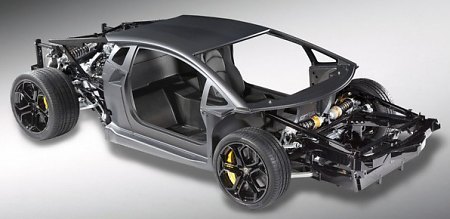
|
|
Carbon-fiber
chassis and pushrod suspensions are headlines
|
|
Better still, the
carbon-fiber monocoque is built in-house with RTM
(Resin Transfer Moulding) technology co-developed with Boeing and
University of Washington. It utilizes an 80-ton stamping machine to
forge the hot carbon-fiber composites into shape, saving the need for
lengthy fabrication process in high-pressure and high-temperature
chambers, thus reduces production cost by two-third. This allows the
car to have its price inflated by a reasonable 10 percent. At
£202,000 or
€255,000 before tax, the big Lambo is significantly cheaper than
million-dollar exotics like Bugatti, Koenigsegg and Pagani, while
making the slower Lexus LFA (at £340,000 or €375,000) seemed
overpriced.
Apart from chassis, the Aventador has its suspensions upgraded, too.
Now the forged aluminum double-wishbones are controlled by racing-style
inboard horizontal springs and dampers via pushrods, just like Pagani,
Koenigsegg and Ferrari Enzo. This reduces unsprung weight and gives
more
freedom to tuning. On the downside, the car does not offer any kind of
adaptive suspensions – the Ohlins dampers here are passive, a far cry
from Ferrari's magnetorheological adaptive dampers. Perhaps Sant'Agata
has spent too much money on the chassis already.
 |
|
Polygons
and zigzags inspired by Reventon
|
|
As expected, the bodywork is made largely of carbon-fiber, with the
exception of the aluminum bonnet, doors and bumpers. The new body shell
allows the fitment of larger wheels, measuring 19 and 20-inch front and
rear respectively. This in turn allows larger Brembo CCM ceramic brake
discs – 398mm with 6-piston calipers up front and 380mm with 4-pot
calipers at the rear.
At 1575 kg dry, the
big
Lambo is still hardly a lightweight. It is 80 kilograms heavier than a
Ferrari 599 GTO and almost 300 kg more than a Koenigsegg. However,
considering the car has a big V12, all-wheel drive system and
relatively luxury features for a supercar, I would say the weight is
reasonable, if not one to be worth special mention.
Powertrain
The original 3.5-liter V12 launched in 1963 employed seriously
oversquare combustion chambers to achieve high rev and power. Over the
years, it gained capacity, reached maximum bore limit and then majored
on lengthening stroke. Ultimately, the 6.5-liter version on LP640 had a
slightly undersquare profile of 88 mm x 89 mm. Now with the opportunity
to do it all over again, the new L539 V12 has its combustion chambers
returned to oversquare profile of 95 mm bore and 76.4 mm stroke.
Displacement remains unchanged at 6.5 liters, which is already very
large indeed.
Specification-wise, the L539 is pretty conventional. It has a 60-degree
V-angle, DOHC 48 valves, dual-VVT and variable intake manifolds like
its predecessor. The aluminum cylinder block is still inserted with
cast-iron cylinder liners rather than coated with modern silicone
spray, while connecting rods are made of forged steel rather than
lightweight titanium (note: both are acceptable as the short-stroke
engine has no difficulty to rev to 8500 rpm). Most surprising of all,
it does not get direct fuel injection like its smaller sibling Gallardo
or its new generation Ferrari rivals. Lamborghini admitted it had
problems to get the exhaust emission right without sacrificing output
power, so DI has been put on the agenda for its next evolution. Like
the passive suspension, this implies a tightly controlled development
budget.
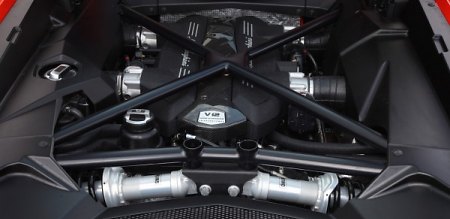 |
|
No
direct injection, but still 700 horsepower.
|
|
Having said that,
with a
higher compression ratio (11.8:1 instead of the previous 11.1:1), a
more powerful engine management system, more efficient scavenging
lubrication pumps and the aforementioned reprofiled combustion
chambers, the engine is capable of higher rev, more power yet a broader
spread of torque. It produces a maximum 700 hp at 8250 rpm and 509 lbft
of torque at 5500 rpm, an improvement of 30 horses and 22 lbft from the
last LP670-SV. A modest boost perhaps, it is nonetheless a good
starting point for further evolutions to come.
However, the biggest improvement is not output, but the packaging of
the engine. It continues to use dry-sump lubrication, but the new sump
is made much thinner, allowing the crankshaft to sit 75 mm lower in the
chassis than before, greatly lowering center of gravity. The engine is
also made lighter, with its weight reduced from 253 kg to 235 kg,
thanks partly to a new aluminum-silicon alloy. The lower mass of the
engine also helps shifting one percent of weight away from the rear
axle. Weight distrubtion is now 43:57 front to rear.
The V12 is mated to a new 4-wheel drive system. As before, the gearbox
is situated forth of the engine and inside the transmission tunnel of
the cabin to benefit weight distribution. What's new is front/rear
torque split device, now a Haldex 4th generation electromagnetic
multiplate clutch instead of the old viscous coupling. In other words,
a computer-controlled, active torque-split device replaces a passive
mechanical device. It should be a big plus to the new car.
Front-to-rear torque spilt can vary from 0:100 to 60:40 depending on
needs.
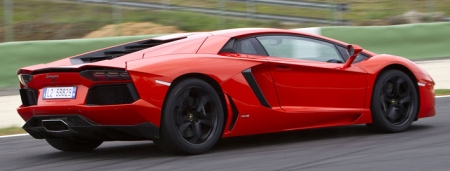 |
|
Better
weight distribution; Haldex 4WD improves traction.
|
|
The gearbox is also
all-new. Controversially, Lamborghini decided to skip the popular route
of double-clutch gearbox (due to limited development budget again) and
opt for a new kind of automated manual gearbox. The 7-speed ISR
(Independent Shifting Rods) transmission is a joint-development with
Italian transmission expert Graziano. It weighs 79 kg, considerably
lighter than a dual-clutch alternative, yet it can make gearshift in a
lightning 50 ms - faster than the 60 ms taken by Ferrari 599 GTO and a
night-and-day difference to the 200 ms on the outgoing E-gear ! How
is this achieved? The ISR gearbox uses 4 shift rods to manipulate
gearshifts simultaneously. As one rod is disengaging a gear, another
rod is already engaging the next gear. These actions partially overlap
so to save time. However, it cannot fully pre-select the next gear like
a dual-clutch box because there is only one clutch.
Sadly, the arrival of ISR gearbox means the end of traditional manual
gearbox. Because most customers ordered E-gear in the previous
generation, Sant'Agata decided not to offer manual box alongside the
ISR. The ISR is pretty versatile. It offers 3 modes - Strada (street),
Sport and Corsa (race). The first two also allow full automatic
operation. Apart from gearshift speed and smoothness, these modes also
alter throttle, steering, 4WD torque split and stability control.
Interior
Inside, the
Aventador's
cockpit still features a large transmission tunnel, but ergonomics,
build quality and equipment are all vastly improved. First, you will
find it easier to enter the cockpit, thanks to a lower and narrower
door sill. Once settled on the seat, you will find the relationship
between yourself and the controls is far more rational than before. The
instrument pod and center console are finally close enough. The
steering wheel is fully adjustable. The foot well still biases towards
the center, but with the demise of clutch pedal foot room becomes less
cramped. There is decent room for head and elbow. Visibility is good
for the road ahead, more challenging rearward through the shallow rear
window and louvers, but at least you get a standard rearview camera now.
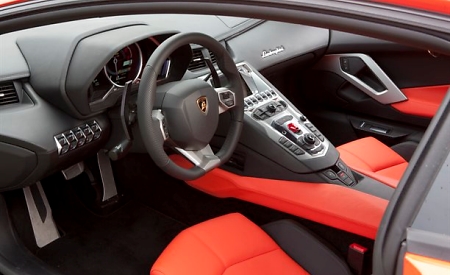 |
|
While
looking cool, cabin delivers an uncomfortable smell of gimmick.
|
|
The interior design tries hard to be special, as seen from the
extensive use of polygonal elements and contrasting colors. It could be
more tasteful though. The combination of classic toggle switches and
modern LCD instrument panel is strange, especially when the latter
provides no more functions than conventional dials – unlike Ferrari's
which is integrated with multimedia display. The new instrument allows
you to switch between analogue speedometer plus digital tachometer and
analogue tacho plus digital speedo. While looking cool, it delivers an
uncomfortable smell of gimmick.
Plenty of switchgears come from Audi. Some do not gel with the exotic
cockpit, such as the rectangular air vents (from A6), but they do work
flawlessly. The reskinned Audi MMI multimedia control interface is much
much better than the cheap sat nav on Ferraris.
Strangely and disappointingly, the cabin is completely covered with
leather, alloy and plastic, with none of its carbon-fiber surface
exposed to sight. If you want to have it uncovered, you will have to
pay extra for hotter variants (e.g. SV) in the future.
On the Road
Press the hexagonal Start button and the V12 comes into life. The first
impression is very different from the old engine – it is much smoother,
quieter and more cultured, more like a Ferrari V12. Power delivery is
more linear than ever. It is more tractable low down, pulling eagerly
from 2000 rpm all the way to 8500 rpm like a gas turbine, without any
obvious steps in the wide spectrum. Less dramatic you may say, it is
perfect for accessing performance in bends.
At 3000 rpm, the noise is as subdued as the old engine at idle. This
makes Aventador a better companion for highway cruising. Floor the
throttle, the electronic tacho needle climbs instantly beyond 5000,
6000, 7000 and 8000 rpm. The noise gets loud and angry, releasing the
true personality of the fighting bull. The sound is addictive, although
it lacks the hard edge of 599 GTO.
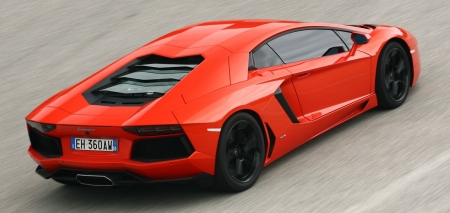 |
|
Full-bore
launch is sensational, thanks in part to violent gearshifts.
|
|
Full-bore launch
under
Corsa mode is a breathtaking experience. The thrust is so strong,
accompany with a violent kick at your back during each upshift. Yes,
the ISR gearbox is nowhere as smooth as today's double-clutch
gearboxes, as
each gearshift comes with a short pause followed by a brutal
re-engagement,
but it is this drama that makes the Lamborghini's acceleration feel
more spectacular than that of Bugatti Veyron, even though it is
actually slower. Another advantage is a razor sharp throttle response,
something not its turbocharged rivals can match.
Straight line acceleration is a strong card of Aventador, as it is
benefited by more power, less weight, a more sophisticated 4WD system
and electronic launch control. Lamborghini claims an incredible 0-60
mph time of 2.8 seconds, which is merely slower than Bugatti Veyron and
quicker than anything else we have seen. Is it really that quick?
Independent test results from Quattroruote magazine confirmed this.
Auto Motor und Sport recorded slightly slower times, with 0-60, 0-124
and 0-186 mph done in 3.0, 9.4 and 24.8 seconds respectively. The last
figure puts it just behind Bugatti (14.9s for SS and 16.8s for standard
car), Koenigsegg CCX (21.9s), McLaren F1 (22.4s) and Pagani Zonda
Cinque perhaps, while jumping ahead of Ferrari Enzo (26.1s) and leaving
599 GTO for dead. The Lamborghini has greatly narrowed the gaps
from those million-dollar exotics. That alone is a great achievement
for a production car aiming to sell 750 units annually.
As for top speed,
we
have
no reason to doubt its 217 mph claim. Whether it manages 210 or 220 mph
in Nardo or Ehra-Leissen is not important. What counts is that drivers
will find it effortless to break 200 mph on Autobahn, by the time the
car is still accelerating.
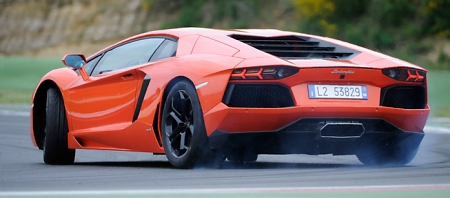 |
|
Understeer
remains in slow corners; Ovesteer now more friendly.
|
|
Performance aside, the Aventador is also a far better car to drive than
Murcielago. It steers better. It stops better. It rides massively more
refined. It slips through the curves more precisely. It feels far
lighter than its predecessor. In a nutshell, it makes LP670-4 SV feel
ancient.
But what else would you expect? The most important question is: how
does it compare with other excellent supercars? That is more difficult
to answer. For a car so big and heavy, there is always a limitation in
its agility, even though the Aventador hides it quite well. If you
compare it with Ferrari 458 or McLaren MP4-12C, you will find it still
feels cumbersome on regular roads. The sense of its massive width can
never be overcome. Same goes for the initial understeer that built into
its DNA to keep it safe in corners. Yes, the understeer is already less
than its predecessor, but it is still there, especially at slow corners.
It is difficult to say whether the Aventador produce more grip in
corners than the last SV, which was already very good in this aspect,
but it does show a far friendlier manner at cornering limit. While the
old car would scare you with plenty of oversteer, the new car is stable
and planted. Oversteer comes at a modest rate. In fact, on public roads
oversteer is virtually impossible to induce. You need a race track to
access power slide. That also limits its driving fun a bit when compare
with smaller supercars as well as the better balanced 599 GTO.
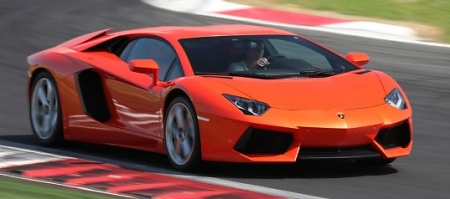 |
|
Amazingly
capable on track; not so on mountain roads.
|
|
The ride quality is
definitely better than any Murcielagos, thanks partly to the immense
solidity of its carbon-fiber chassis. Nevertheless, it is not to say it
can compare with the adaptive Ferraris, let alone the
hydraulically-suspended McLaren MP4-12C. The fixed rate dampers mean
Lamborghini can only choose to favour part of the spectrum. It chose to
deliver a beautiful high-speed ride, leaving low-speed ride very hard.
Consequently, the big Lambo is not the best tool to thread through
mountain roads.
The steering is another example of "improved but not quite to up the
class best". Compare with its predecessor's, it requires less effort to
turn and shows less shake through the steering column, if not have the
latter completely resolved. It lacks the transparency of Ferrari helms,
probably due to the extra 4-wheel drive mechanicals.
Likewise, the ISR gearbox is far smoother than the old E-gear – even
can be called "refined" in Strada mode – but in Sport mode the
gearchanges are far jerkier than the dual-clutch boxes on its rivals.
Corsa mode is even more unforgiving, thus is best to leave for track
days.
However, the brakes are by all means top class. They have the power to
stop the big Lambo in the same distance as lighter rivals. Pedal feel
is great, too.
 |
|
Those
rough edges contribute to its character...
|
|
The Aventador feels most
at home on wide, flat and fast roads, or even better on tracks. Attack
a fast bend, the car settles with some initial understeer and then the
Haldex clutch starts sending more torque to the front wheels to balance
the car. Bury the throttle on corner exit and you will be amazed with
the immense force that punches the car forward while keeping it on
rails. The cornering power of this car is simply sensational, more so
than Bugatti.
As Quattroruote magazine found out, it could beat MP4-12C, 599GTO and
911GT3 RS convincingly on a fast track. That could be a surprise for
something so big and heavy. Its all-wheel traction, superior power and
low center of gravity all help to excel on track.
Which comes to our conclusion: is it better than its rivals? That
depends on your preference, of course. If you love to exploit your
supercar regularly on narrow B-roads, nothing could be better than a
compact McLaren or Ferrari 458. If all you want is a car to shine on
the world's fastest roads every Sunday morning, plus a spectacular
look, a bit of uncompromising character
and the most exotic bloodline to appreciate in the rest of the week,
the big Lambo remains the very best. A perfect supercar it isn't, but
just like its ancestors, those rough edges contribute to its character
and make it all the more desirable. |
Verdict:      |
Published
on 30
May 2015
|
All rights reserved.
|
|
Aventador LP750-4 SV
|
|
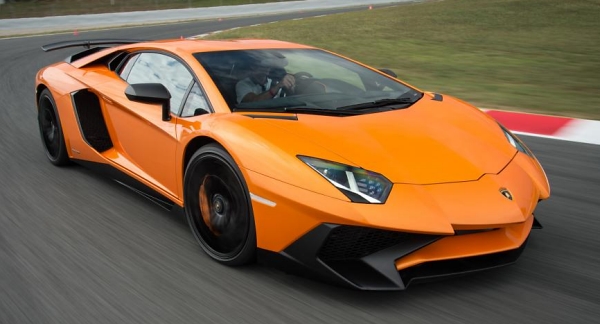 |
|
Lighter,
more powerful and faster than the standard Aventador, but it is a lot
more than numbers…
|
|
The SV badge was first used
on Miura in 1971. Standing for Super Veloce, or Super Fast in English,
it represented the go-faster version of Lamborghini’s supercar.
Countach did not use this badge throughout its life, but since Diablo,
every generation of Lamborghini’s V12 machine must have an SV
derivative. The current Aventador is no exception. Like its ancestors,
LP750-4 SV is lighter, more powerful and faster than the standard car.
It carries 50 kg less weight, while its engine pumps out an extra 50
horsepower. The result is a power-to-weight ratio lifted by 10 percent,
and 0-60 mph sprint reduced by a tenth to 2.7 seconds. However minor
these improvements sound, on the road it feels a very different beast –
in fact, a lot more than the numbers suggested…
Let’s see what have been modified first. This is obvious from the
outlook. The standard Aventador is already one of the most aggressive
looking cars on earth. However, “one of the most” is not enough to
Sant’Agata. It wants to be on top. So the SV gets even more aggressive.
Its nose and front splitters get pointier and together form a big
trident (take note, Maserati). Black carbon side skirts make its body
appear to be slimmer. The flying buttresses no longer feature pop-up
intakes but 4 fixed intake ducts, again made of carbon-fiber. At the
rear, there are larger diffusers, new quad-exhaust, more ventilations
and a fixed carbon rear wing. The latter can be adjusted to 3 different
angles manually. That body-colored diffuser top cover mirrors the upper
plane of front splitter. It’s a clever design, not only adding style
but also relieving the visual mass of the tail. Lamborghini design is
finally back to the top!
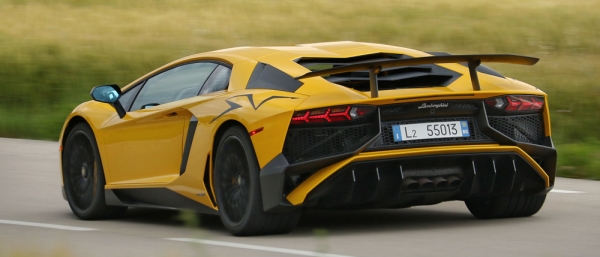 |
|
“One
of the most” is not enough to Sant’Agata. It wants to be on top.
|
|
The extra aero kits boost downforce by 170 percent. At 280 km/h or 174
mph, there is now between 186 and 218 kg of positive downforce
depending on the rear wing angle. You might ask why the latter vary so
little. I suppose that is because the Lamborghini lacks active aero
(unlike Ferrari and many other supercars), so keeping the rear wing
downforce within a narrow window will not alter front-to-rear balance
too much. Curiously, the quoted top speed of 217 mph is the same as
the standard Aventador, and it is achievable with the highest downforce
setting, so it is obviously regulated by electronics.
De-restricted, it might be capable of over 220 mph!
That is perhaps not a surprise when you consider the car has 750
horsepower on offer. Aston Martin’s 7.3-liter V12 on One-77 remains to
be the most powerful naturally aspirated engine on earth, but the
Lamborghini comes within 10 horsepower with smaller displacement (okay,
you might say the same thing to Ferrari F12, whose engine is smaller
again and 10 hp adrift). The Lamborghini 6.5-liter V12 has yet to get
direct injection, but its modified valve timing, intake manifolds and
exhaust with lower back pressure are already enough to squeeze out
another 50 horsepower at 8400 rpm, 150 rpm higher than the previous
peak, although maximum rev is kept at 8500 rpm. Maximum torque is
unchanged, too, but with 509 pound-foot you don’t need to beg for more.
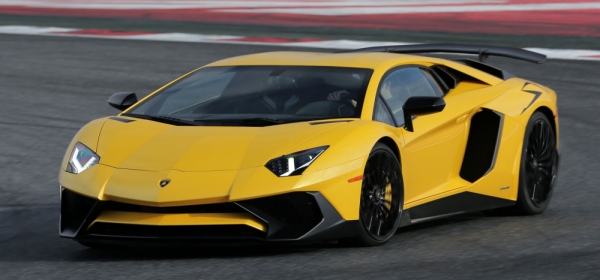 |
|
What
makes the Lamborghini V12 special is its soundtrack, and you get more
in the SV.
|
|
At normal pace, it is hard to tell if the engine is different from the
standard unit. Rev it closer to the top end, you can feel the extra
shove and enthusiasm for rev. Its throttle response is even sharper
than the standard engine, especially in Corsa mode. However, what makes
the Lamborghini V12 special is its soundtrack, and you get more in the
SV because of the quad-exhaust and reduced sound insulation throughout
the cockpit. Beyond 8000 rpm, it is shockingly loud and addictive.
The 7-speed ISR gearbox has its shift quality improved a little, but
you still won’t confuse it with a dual-clutch gearbox. In the more
aggressive modes, every gearshift is accompanied with a shockwave. That
said, it matches the aggressive character of SV.
The 50 kg weight reduction is achieved by using carbon-fiber for more
body parts, such as bonnet, doors and rear wing, as well as a stripped
out interior. It has infotainment system, carpets and most sound
insulation discarded. The carbon-fiber bucket seats are also lighter.
It goes without saying less weight leads to better handling. However,
even more influential are 3 other modifications.
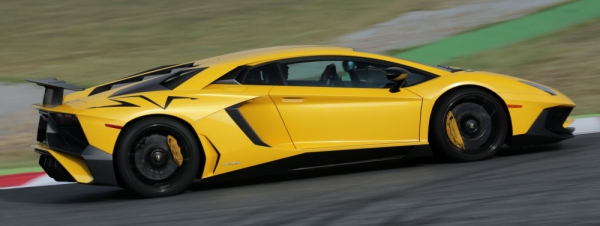 |
|
While
the standard car feels a little bulky and understeery at initial
turn-in, the SV steers much more responsively.
|
|
The first is the Pirelli P-Zero Corsa tires. They are an inch taller
and shod around larger forged alloy wheels. As implied by the Corsa
label, these semi-slicks don’t last as long as the regular road tires,
but they offer tremendous grip and are fine for some flying laps on
track. The second is the addition of magnetorheological adaptive
dampers. In Strada mode they add new-found ride comfort
to the big Lambo, even though the spring rates are slightly increased.
In Sport and Corsa modes, the stiffened damping have body movement more
tightly controlled, maintaining composure over small bumps or kerbs.
The third is the new variable-ratio electrical power steering. It is
also found on Huracan, but this one has been improved to behave more
consistently (it locks the ratio once you have entered a corner). Quite
amazingly, it has the handling of Aventador transformed! While the
standard car feels a little bulky and understeery at initial turn-in,
the SV steers much more responsively, thanks to the quick ratio adopted
at lower speeds. It’s not quite as direct as the racks of Ferrari 458
or F12, but it is quick enough to make the big Lambo feels agile and
alert for the first time. Admittedly, the retuned Haldex 4WD system is
also cooperative to cut understeer.
On track, all these elements gel to make the SV the most exciting
Lamborghini to drive by some margin. It feels sharp, responsive and
even edgy. Corner entry comes with a little understeer, which is fine
for security, but it will adjust the line if you lift off mid-corner.
Apply a heavy dose of power again, you can swing the tail outward – and
massively if you want! Ultimately the 4WD and stability control will
catch it, but before that happens you have the option to alter the
balance with throttle. Mind you, it is not as easy to control the
balance as the lighter and less powerful 458 Speciale, McLaren 650S or
911 GT3 RS. You have to be more delicate with throttle and brakes. But
the option is there and what you need is more practice to understand
its temper. Lamborghini’s handling has never been so interactive!
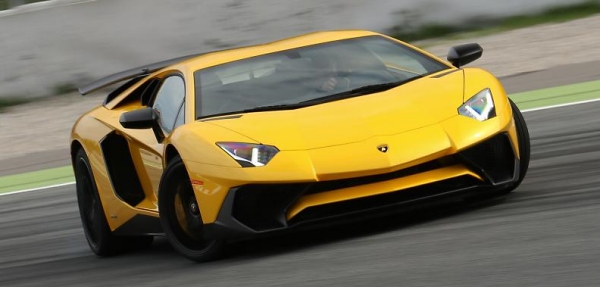 |
|
Lamborghini’s
handling has never been so interactive!
|
|
By this time you must have watched the official video showing the SV
lapping Nurburgring Nordschleife in 6:59.73. It was recorded in the
only flying lap it attempted, so potentially it could beat the
production car lap record of 6:57, set by Porsche 918 Spyder last year.
That's an incredible achievement for a classic, big naturally aspirated
supercar. It is also at least 20 seconds
quicker than the standard LP700-4. For comparison, the recent Porsche
991 GT3 RS is
only 5-8 seconds quicker than the standard GT3. One can see how giant a
leap the SV
has taken. This has to be one of the fastest cars
in the real world regardless of price!
Speaking of price, the SV is sold at “just” £320,000, versus
£260,000 of the standard car. It is still a relative bargain by
supercar standards. With 600 units slated to production in the next
couple of years, it won’t be exactly exclusive, but few others could
deliver the same visual impact, sensational noise, response and all the
theatrical factors. Welcome back to the top of the game!
|
Verdict:      |
Published
on 21
Jul 2016
|
All rights reserved.
|
|
Centenario LP770-4
|
|
 |
|
€1.75
million plus tax buys you the most aggressive looking Aventador. Isn't
it too expensive?
|
|
Ferruccio Lamborghini was
born in 1916. To celebrate the 100th Anniversary of the birth of its
founder, Lamborghini introduces the limited edition Centenario. Only 20
coupes and 20 roadsters will be built for buyers already placed orders.
Each costs an eye-popping €1.75 million plus tax. Considering its
rarity, it might sound a bargain compared with the €2.4 million Bugatti
Chiron, but then again the Lambo is less special, because it is
practically a rebodied Aventador SV. Based on the same running chassis,
6.5-liter V12 and 4-wheel-drive powertrain, the Centenario adds
only 20 horsepower to the equation thanks to none other than remapping
the engine management system, which raises its redline by a scant 100
rpm and maximum output to 770 hp at 8500 rpm, all the while without
altering torque production. Its top speed is unchanged at 217 mph,
while 0-60 mph is still accomplished in 2.7 seconds – admittedly, any
cars achieving acceleration performance at this level is hard to
improve further. According to official figures, you need to go to 300
km/h (186 mph) to see it pulls away from the SV by half a second. You
pay an extra €1.4 million for that slim advantage. Is it worthwhile?
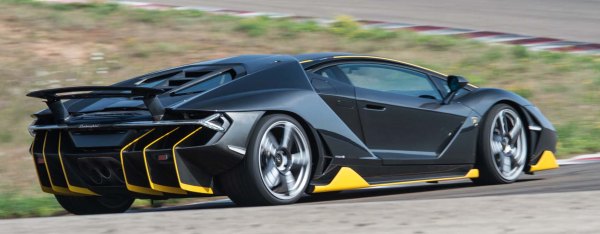 |
|
You
pay an extra €1.4 million for half a second advantage in 0-300 km/h.
|
|
In performance terms, it is definitely not. From collector’s point of
view, if you have an acquired taste on styling, it might be. The
Centenario is the maddest, baddest looking Lamborghini of all.
Beautiful it is not, but it certainly turns head. It’s so aggressive
that I suppose Batman would be eager to get one in stock form. Although
the wedge body shape is familiar, the surface treatment is far more
aggressive than Aventador. Up front, its nose features a more effective
double-plane air splitter which draws air towards the two ducts
sculpted in the bonnet, certainly adding downforce. The front splitter
is added with vertical strakes which are painted in yellow to catch
attention. At both sides, there are yellow vertical blades added to the
skirts to improve air flow. The upper and main side intakes have been
combined to a massive single unit, covering the entire trailing edge of
the door like Bugatti Chiron. This has a big visual impact to the car,
making it looks hotter and more performance-oriented. At the back, the
thoroughly redesigned diffuser is not only larger but it features 6
vertical blades, which are again yellow-tipped to catch eyes. The rear
wheels are now half-exposed by the open diffuser, a reminder to
Countach. Above the diffuser, a new hydraulic rear wing can raise
vertically by 150 mm and tilt for up to 15 degrees. It alone generates
227 kg of downforce at 280 km/h (sadly, Lamborghini won’t reveal the
total downforce generated by the whole aero package). It goes without
saying the new bodywork is made entirely of carbon-fiber.
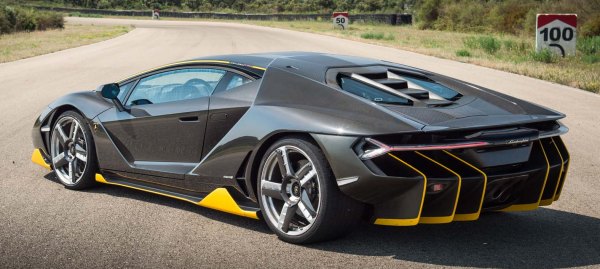 |
|
It
is a more track-oriented machine than the SV. For pure road use, we
might prefer the SV.
|
|
On the road, the new aero is unlikely to make a discernible difference,
but on a race track you can feel the extra downforce at fast bends,
which allows the Centenario to grip harder and corner faster. Another
discernible difference is the new active rear-wheel steering, something
Porsche and Ferrari already used in some of their cars, but the first
time on Lamborghini (though it will be applied to all Aventadors
later). Below 45 mph, the rear wheels turn up to 3 degrees in opposite
direction to shorten turning circle. Above that speed, they steer in
the same direction to enhance directional stability. As a result, the
Centenario feels more agile in town and slow corners, but more stable
when you are committed to the driving. Unfortunately, some of the
playful oversteer of the SV has been lost. In addition to the stiffer
adaptive damper tuning, the use of rigid suspension bushings and
reduced sound insulation, the Centenario is a more track-oriented
machine than the SV. For pure road use, we might prefer the SV.
More universally welcomed is the improved tuning to the ISG
transmission, whose gearshift is slightly less violent than before. The
upgraded infotainment system with a larger portrait touchscreen is also
welcomed. No doubt both will be seen on lesser Aventadors, too, because
it doesn’t make sense to develop them for only 40 cars.
For so much money, you can buy a LaFerrari, McLaren P1 or Porsche 918
Spyder with change. Why are there still people wanting the rebodied
Aventador? Especially when Lamborghini already introduced Reventon and
Veneno a few years back? And why is Aston Martin able to launch batch
after batch of ultra-expensive limited editions? It proves that not
only the world has too many rich people, but the coach-building
industry has returned to prosperity not seen since the 1930s.
|
Verdict:     |
Published on 26
Jan 2017
|
All rights reserved.
|
|
Aventador S
|
|
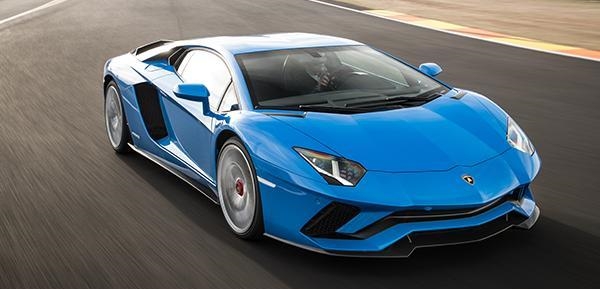
|
|
Just
as Miura S, Aventador S has a difficult task to fulfill, but it does
that beautifully.
|
|
Aventador S, what a simple
name. The last time we saw Lamborghini used simply an “S” to represent
an updated version, rather than the cumbersome LPXXX-X nomenclature,
Ferruccio was still taking charge of his company. That was Miura S. The
original Miura was known for jaw-dropping beauty and wild performance
claims, but its chassis was seriously underdeveloped. It was Miura S
that finally had most problems sorted out and realized its promises.
Aventador S is just the same. As much as we loved the original
Aventador – for its shape, brutal power and all flaws that became part
of its character – we have to admit that it no longer meets the
expectation for a supercar today. Junior supercars like McLaren 675LT
and Ferrari 488GTB are a lot lighter, more agile, more precise to
control and, ridiculously, even faster in straight line. The big Lambo
feels outdated in comparison. Therefore, Aventador S has a difficult
task: it needs to have the rough edges rounded, to lift agility and
precision dramatically and to prove that the V12 mid-engined format is
still relevant to today's requirements. The letter S might sound
simple, but it actually carries a lot of weight.
The Aventador S looks cleaner than the old car thanks to a restyled
nose with new intakes and front splitter – the latter generates 130
percent more front downforce. At the back, it adopts the SV's fixed
intake ducts at the C-pillars, replacing the retractable units of the
old car that I loved so much (sadly). The diffuser also
gets closer to the spec. of SV, but the centrally-mounted triple-pipe
exhaust is unique. Made of titanium, the latter saves 6 kg.
The chassis has received equal attention. For the first time, the
standard Aventador is equipped with adaptive dampers. These advanced magnetorheological
units are borrowed from the SV. Meanwhile, the recent Centenario
special lends its active
rear-wheel steering. To cope with these changes, the Aventador S has
revised its suspension geometry, rear springs, stability control
setting and even adopts a set of Pirelli P Zeros with new compounds.
Surprisingly, its dry weight stays at 1575 kg, as the weight of
rear-wheel steering hardware is offset by the lighter exhaust.
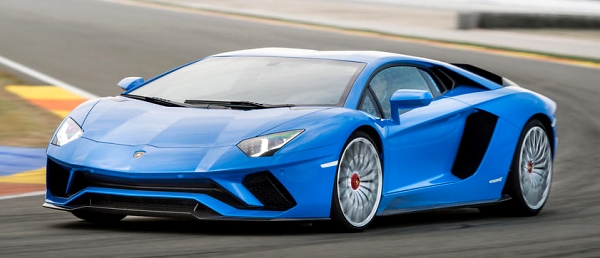
|
|
With
4WS, it no longer feels clumsy to handle. Its chassis dynamics is a big
step forward!
|
|
The most influential change is definitely the rear-wheel steering. Like
rivalling systems on Porsche and Ferrari, at low speed it
steers the rear wheels in direction opposite to the front wheels to
sharpen the turn-in, and in the same direction at high speed to enhance
stability. However, Lamborghini uses it more aggressively – it steers
the rear wheels up to 3 degrees in opposite direction and 1.5 degree in
the same direction. This effectively equals to shortening the wheelbase
by 500mm in tight corners, or lengthening the wheelbase by 700mm at
high speed. Moreover, to deal with the understeer problem
of Aventador, it keeps counter-steering the rear wheels until 70-82 mph
(depending on many factors), way higher than other applications we have
seen so far. As a result, the Aventador S has its notorious understeer
largely banished. Its turn-in becomes much sharper, more so than the
SV. It feels lighter and more agile, too, although it would be
irresponsible to say it felt as agile as those lighter supercars. The
enhanced agility also comes from the retuned stability control and
Haldex 4WD system, which can keep 90 percent torque at the rear axle so
that it finally feels like a rear-drive machine. You can adjust the
driving line with throttle and even push the tail slightly outward. The
big Lambo no longer feels clumsy to handle. Its chassis dynamics is a
big step forward!
The new car gets also the SV’s variable-ratio electrical power
steering. Working in harmony with the active rear steering, it makes
tight corners handy to turn. Its direct gearing requires much less
steering effort, while on highway it asks for fewer corrections. Both
precision and feedback have been improved.
The magnetorheological adaptive dampers maintain tight body control
while improve ride comfort. No, it is not as supple as McLarens or
Ferrari 488, but compared with the old car its ride feels smoother in
any
of its 3 suspension modes.
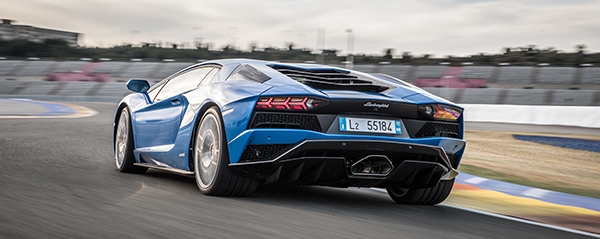 |
|
The
weakest link is again that ISG gearbox...
|
|
Is the car any faster? The 6.5-liter V12 is largely unchanged, but
with revised variable intake manifold and increased valve overlapping
it gets closer to the state of tune on SV. It produces 740 hp at 8400
rpm, up 40 ponies, while torque stays the same. Strangely, Lamborghini
still quotes the same 217 mph top speed and 0-60
mph time of 2.8 seconds. 0-124 and 0-186 mph are slightly quicker than
before, but it still trails the lighter SV as well as the
aforementioned Ferrari and McLaren junior supercars. However, the
Italian V12 still produces one of the most memorable noises in the
world, something not a flat-crank V8 could replicate. Its aural thrills
and its instantaneous throttle response more than make up
for what it loses in ultimate performance.
Unfortunately, the weakest link is again that 7-speed ISG gearbox. As
it is left untouched in this update, its gearshifts are either slow or
brutal, depending on driving modes. Its torque interruption and
subsequent kick feels like industrial grade in the world of
dual-clutches. This seriously hampers its driving satisfaction. Perhaps
it is time to invest into a new gearbox?
The Aventador S is unquestionably a huge improvement over the original.
It has most problems sorted out, most notably the understeer, clumsy
handling and stiff ride. In many ways it feels as great as the SV,
perhaps even more agile. The SV is a sharper weapon on tracks, thanks
to its Corsa tires, extra downforce and weight reduction, but the
Aventador S is a better road car. It is still troubled by an outdated
gearbox and some limitations inherited from Countach, such as lack of
headroom, limited visibility and difficult access to the cabin. Some
may say it is not as user friendly as junior supercars, while
billionaires might think it is not special enough. However, with more
than 1000 cars sold every year, its formula seems to be quite
successful so far. The S should keep the legend alive.
|
Verdict:     |
Published
on 26
Oct 2018
|
All rights reserved.
|
|
Aventador SVJ
|
|

|
|
SVJ
is the most track-oriented big Lamborghini to date.
|
|
Aventador has been around
for nearly 7 years. Although it is more approachable than any “big
Lambos” preceding it, it remains huge and brutal, even in the latest
form of Aventador S. Can Lamborghini build a track-oriented V12 machine
to rival McLaren Senna, Porsche 911 GT2 RS or Ferrari 488 Pista on
track days? No one had thought about that question, I suppose. As good
as the late SV, it was not light, agile and controllable enough to be a
track weapon. A smaller Huracan Performante might be closer, but the
laws of physics deny the big Aventador a chance. However, a road course
like Nurburgring Nordschleife is another matter. It has some straights
allowing the V12 supercar to go beyond 200mph, while various kinds of
bend give the 4WD machine an edge. Moreover, Sant'Agata already gained
a lot of experience in Nurburgring, including the previous lap record
set by its Performante last year. This ambition led to the development
of the ultimate Aventador, SVJ.
The name SVJ takes some explanation. In the early 1970s, Lamborghini
created a few Miura SVJ for some very wealthy customers. Benefited with
a more powerful engine, wider tires, light alloy bodywork and improved
aero, they were the fastest Miura ever built. The SV stands for Super
Veloce, or Super Fast. J stands for Jota, the Spanish pronunciation of
the letter J, because the earlier prototype by which they were inspired
was designed according to FIA Appendix J specifications. Therefore, the
track pretension of Aventador SVJ is quite obvious.
Back in July, this car rewrote the Nurburgring lap record for
production cars with a time of 6:44.97. That's 15 seconds quicker than
the old SV and just over 2 seconds faster than the shortlived record
held by Porsche 911 GT2 RS. Long-lasting it might not be, but
considering its size and weight – the latter is identical to the SV,
this achievement is incredible!
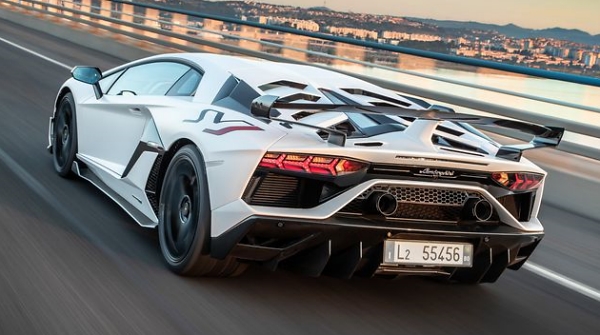
|
|
Considering
its size and weight, its new Nurburgring lap record is incredible.
|
|
The first contributor to the improved lap time is a modified V12 motor.
The basics are unchanged, but Sant'Agata fitted it with lightweight
titanium intake valves, more aggressive cam profiles, higher flow
intake ports and manifolds as well as a less restrictive and lighter
exhaust. The friction of pistons and crankshaft are also reduced. The
result is 770 horsepower at 8500rpm, 20 and 30hp up from the SV and S,
respectively. Its maximum rev is lifted by 200rpm to 8700rpm. Equally
important, the torque curve gets higher and flatter, producing more
torque across the rev and sustains until higher rpm. Maximum torque is
lifted from 509 lbft at 5500 rpm to 531 lbft at 6750 rpm.
Lamborghini stresses that a major factor contributing to its
performance is the ALA active aerodynamic system, now in second
generation. It consists of 2 movable flaps in the revised front
splitter, closed to direct air flow towards the outlets on the top of
the nose to generate downforce, or opened to direct air flow towards
the vortex generators on the underside of the car, so to reduce drag.
At the back, the bi-plane carbon-fiber rear spoiler is fixed, but it is
also equipped with active aero tricks. At the base of its center
pillar, there is an air scoop drawing air into the hollow pillar,
splitting left and right towards the hollow wing foil and blows out
from the tiny slots located underside of the wing foil. The scoop has
again 2 flaps. When they are closed, no air enters the rear spoiler
thus the latter works normally to produce maximum downforce. When the
flaps are opened, the airstream blowing out from the underside slots
creates some kind of air cushion, altering the path of the normal air
flow, reducing both drag and downforce. When the car is cornering, it
can close one flap and open another, generating more downforce at the
inside wheels to counterbalance the cornering load. Other aerodynamic
tweaks include the vertical side fins at the front overhang and
enlarged engine cooling intakes at the body sides. Overall, Lamborghini
claims the car generate 500kg downforce at top speed, or 40 percent
more than the SV, while drag coefficient is reduced by 1 percent.

|
|
ALA
includes a trick rear spoiler.
|
|
Having said that, Lambo guys admitted that ALA contributed to only 1 to
3 seconds at Nurburgring, which is rather slim for a 6 or 7-minute lap
I would say. The majority should be down to the improved chassis. The
SVJ has its anti-roll bars stiffened by 50 percent, damping rate lifted
by 15%, and its 4WD system transfers 3 percent more power to the rear
axle. The Haldex clutch now completely disengages the front axle under
braking to reduce understeer. Besides, the rear-wheel steering hardware
of Aventador S has been adopted.
However, the biggest contributor to its improved lap time has to be the
optional Pirelli P Zero Trofeo R rubbers (P Zero Corsa is standard
fitted). Needless to say, these semi-slicks are very sticky but also
prone to wear. No wonder even in the press launch test in Estoril
track, Lamborghini opted to fit all the test cars with the lesser Corsa
tires, because it could not afford to change tires every few laps for
so many cars! The Trofeo R is said to take 10 seconds out of a
Nurburgring lap. Adding a couple of seconds for ALA and the modified
V12 each, you get the 15 seconds improvement over the old SV.
On the Road
The first thing you’ll notice about the SVJ is its spectacular looks.
Aventador has
always been spectacular, but this one has even more aggressive aero
kits to catch attention. Once entered, however, you will find it keeps
all the old vices, say, short of headroom if you are taller
than 6 feet, and visibility is unquestionably the poorest in the world.
In fact, the new engine lid and ALA spoiler makes rearward visibility
virtually non-existent. The rest of the cabin looks a bit dated now, no
matter in design, finishing or the old Audi-sourced infotainment
system.
But once you fire the V12, these problems become insignificant. This is
one of the world’s best engines ever made. Maybe not quite as smooth as
Ferrari’s V12, but it sounds louder and rawer through its shorter
exhaust. Its linear delivery, enthusiasm for rev and instantaneous
throttle response are beyond the comparison of turbocharged motors. In
terms of outright power and acceleration, you won’t feel much
differences from those million-dollar supercars. Although Lamborghini
quotes the same figures as the SV, 217mph and 0-60 in 2.7 seconds are
still very competitive in the supercar world. Only the 0-124 time of
8.6 seconds reveals the downside of its extra weight, inferior
mid-range torque and slower transmission, as it trails a Ferrari Pista
by a full second and McLaren Senna by 1.8 ticks. Nevertheless, you
learn this from timing equipment rather than feel it, because the
overwhelming noise has you fully engaged and shocked. The only
dissatisfaction comes from the ISG automated manual gearbox. It feels
as outdated as ever, characterised by pause and shock in each
gearshift. It goes without saying the ISG remains the weakest link of
the car.
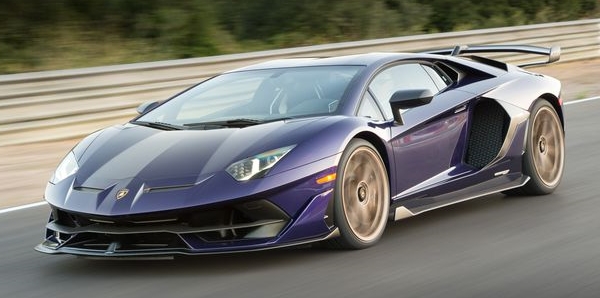
|
|
Louder
and rawer than others, the big V12 is one of the best engines ever
made. Not so good is the ISG transmission and doubtful stability...
|
|
Braking also leaves something to be desired. For a track-oriented car,
its brake pedal feels too soft for the instantaneous response you
demand, although it might be more friendly to drive in urban area.
Moreover, unlike a Senna or just about any track weapons, braking power
starts fading after a dozen of
laps.
With 4WS working, the SVJ certainly feels more agile than the old SV,
if not much over the latest S. Turn-in is sharpened. You need to
recalibrate your brain, applying smaller, more measured steering input.
If you do so, you will find the SVJ has understeer successfully tamed
when entering a corner. Reapply throttle and it powers out of corner
with a neutral attitude unknown to other big Lambos. However, if you
are not focused, applying as much steering as in a conventional
rear-drive supercar while trail-braking into corner, you will find the
rear-wheel steering tucks in the nose more than you expect, and the
heavy engine tries to swing the rear wayward. Even though Corsa mode
has stability control working overtime to tame under/oversteer for the
interest of lap time, it fails to deceive laws of physics entirely.
Although the electronic safety net and power shift of 4WD will
eventually save you from big oversteer, such a sudden instability could
catch you a surprise and demand your quick countersteer. Likewise,
applying or lifting throttle abruptly in corner will trigger
instability. Make no mistakes, the SVJ is no match for a much lighter
Senna, Pista, 720S or GT2 RS for handling precision and agility. You
still need to respect it when pushing it to the limit.
The lesser Sport mode actually loosens the stability control, allowing
more slip angle thus you are freer to play. It will be slower though.
More fun it might be, the big Lambo lacks the transparent communication
and consistent, predicable manner of the aforementioned rivals. For
this reason, I suspect few owners would actually take it to track days.
In fact, the SVJ is not qualified to be a track car. If Lamborghini
really wanted to target it on track, it should have at least stripe-out
its interior and sharpen its brakes. As it is not, it is just the
fastest and best sorted Aventador to date.
Priced at £360K, it is considerably more expensive than the
£270K Aventador S. Some might find it a bargain beside a Senna or
McLaren P1, but it gives you less performance as well as less reward.
Moreover, the so-called limited production run of 900 cars is nearly a
full year’s production volume of the Aventador. You need to be a fan of
Lamborghini to choose it over the very best track-oriented machines
made by its rivals.
|
Verdict:     |
Published
on 24
Mar 2021
|
All rights reserved.
|
|
Sian
|
|
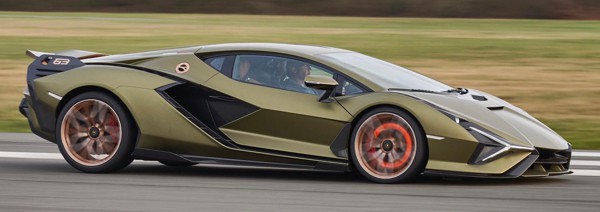
|
|
Mild
hybrid. Wild hypercar.
|
|
Lamborghini, like other
hypercar makers, loves to build limited edition exotic to serve the
richest people on earth. However, while its rivals Ferrari, Porsche,
Aston and AMG spend decent budget to develop truly bespoke and
high-tech cars for this purpose, Sant’Agata follows the same shortcut
path of Bugatti, i.e. reskin its existing production models, giving
them spectacular looks to match equally spectacular prices without
upgrading the substances. In this way, the €1 million Reventon was born in 2007,
followed by the €1.75 million Centenario
in
2016. They were just Murcielago and Aventador in different clothes. No
faster, no better to steer. So why were they all snapped up?
Exclusivity. Only 20 Reventons and 40 Centenario were built, so there
must be enough people with unlimited wealth but limited sensibility to
fill the order list.
After 1 million and 1.75 million euros, the third incarnation should
cost 2.5 million euros, shouldn’t it? So here comes the €2.5M (pretax)
Sian. This time Lambo is a little greedy, wanting to sell 82 cars – 63
coupes and 19 roadsters, indicating the year (1963) Lamborghini was
founded. No problem. They again sold out all cars before its
announcement in 2019. However, it took the next 18 months to get to the
road.
Compared with the already aggressive Centenario and Aventador SVJ, the
Sian’s styling is even more aggressive, and it has a great deal of
Sci-Fi feel. Naturally, it is derived from the SVJ and retains all the
mechanicals, chassis hardpoints as well as windscreen and windows, but
all outer skins are bespoke. It replaces the SVJ’s horizontal styling
theme with vertical one. It gets edgier, even sharper and even lower –
an impression thanks to lowering the sharp crease line on door skins.
The headlight clusters become triangular, while taillights and exhaust
housings are hexagonal. The new active rear wing has fighter jet-style
vertical fins. The rear tires are more exposed at the back to show
their massive width. The roof has a transparent recessed channel in the
middle, paying homage to the original Countach LP400, although it lacks
the latter’s periscope rearview mirror so that the channel is purely a
styling gimmick.
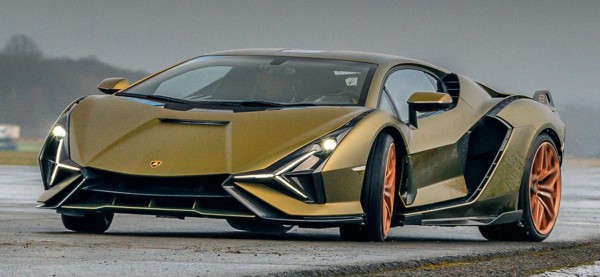
|
|
Sharper
looking than even the SVJ, with a great deal of Sci-Fi feel as well.
|
|
The Sian certainly looks more spectacular than any other members of
Aventador family, but frankly, we are getting used to Sant’Agata’s
overstyling these days. A couple of days ago I saw an SVJ on street,
and surprisingly, despite its ultra-aggressive style, it failed to
catch my emotion as much as I first saw a Countach LP500 in the 1980s.
Not even half the impact. Perhaps we are getting immune to visual
shocks. What Lamborghini needs is not only aggression but the
combination of aggression and taste.
Unlike the bodyshell, the cockpit keeps mostly standard, except trims
and minor details. People say car interior are more expensive to
engineer than exterior. Now I believe.
Mechanically, the chief difference between Sian and SVJ is the addition
of a mild hybrid system. However, instead of battery, the Lamborghini
uses a supercapacitor to store electric power. Supercapacitor is not
exactly a new technology. Some electric buses on the road are using it.
Mazda’s i-Eloop mild-hybrid/start-stop system also employs it. Its
advantage is high power density (kW per kg), but the downside is low
energy density (kWh per kg). This means it is good at providing big
power on short bursts but not providing electric propulsion for
sustaining period. In other words, it is performance instead of
efficiency-oriented. That said, the supercapacitor mild hybrid system
on Sian is pretty mild even in the perspective of performance. Its
electric motor, incorporated into the housing of 7-speed ISG
transmission, produces only 34 horsepower and 26 pound-foot of torque.
Compared with the V12’s rated output of 785 hp (15hp up from SVJ,
thanks to purely tweaking the ECU) and 531 lbft, this is almost
nothing. Moreover, the electric motor is geared to work at speeds up to
only 80 mph, so although the combined power is quoted at 819hp, you
cannot use the electric power at high speed. No wonder the factory
quotes the same performance figures: 217 mph and 2.7 seconds to go from
0-60. Lamborghini talks of 10 or 20 percent quicker in-gear
acceleration
at low speeds. Have we ever judge a supercar on low-speed in-gear
acceleration?
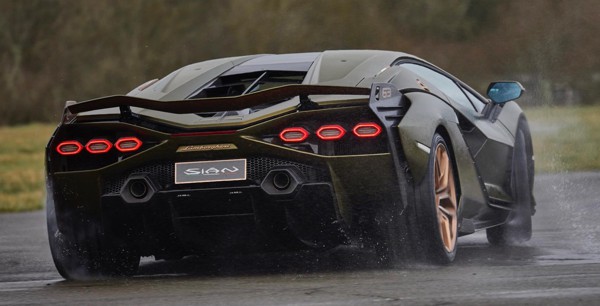
|
|
If
the sound of its V12 is the swan song of the combustion engine era,
then what a song!
|
|
So why is Lamborghini adding this 34 kilograms worth of supercapacitor
and electric motor? The answer is to bridge the torque gap in each
gearshift of the ISG gearbox. Until now, this gearbox remains to be the
biggest weakness of the Aventador. With a single clutch, it is unable
to preselect the next gear like the twin-clutch gearboxes of its
rivals. On the other hand, the torquey and high-revving nature of the
V12 motor presents serious challenges to the transmission design. No
wonder the Aventador has always been criticized for having brutal
gearshifts in faster modes. By filling the torque gap in each gearshift
with electric torque, the Sian feels slightly smoother in full-bore
acceleration, if still not an example of smoothness.
The chassis is virtually unchanged from the SVJ, so that Lamborghini
simply declined to mention. It drives almost in the same style, bar
lacking the downforce of SVJ in higher speed corners. In other words,
agile for such a big supercar, but not quite as forgiving or absorbent
as lighter supercars. On public roads, it is also hampered by its width
and limited visibility.
What makes the Sian more special than other hypercars remains to be the
mighty sound of its V12 – rawer and louder than everything else. Louder
than even the SVJ, perhaps due to less insulation. When the motoring
world is migrating towards full electrification, this aural excitement
is almost certain to be unrepeatable in the future. If it is the swan
song of the combustion engine era, then what a song! From this
viewpoint, perhaps it is worth 2.5 million euros.
|
Verdict:     |
Published
on 1
Nov 2022
|
All rights reserved.
|
|
Aventador LP780-4 Ultimae
|
|
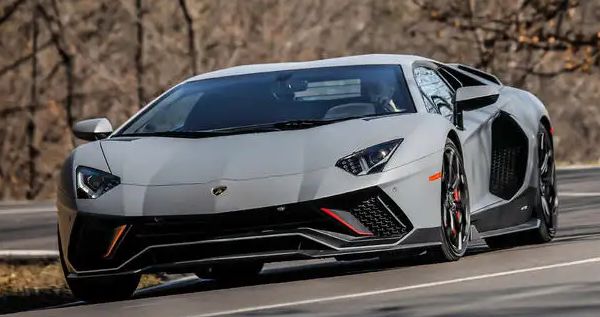
|
|
The
last Aventador is basically an SVJ turned road-going. It keeps all the
good things as well as bad ones.
|
|
After 11 years,
Lamborghini’s big V12 supercar is coming to the end. Before it is
replaced by a plug-in hybrid successor next year, it is given the last
update as a farewell to the last pure combustion Lamborghini. Called
LP780-4 Ultimae, it is the final, if not really the ultimate evolution
of the Aventador. At the time of writing, all 600 cars have been built
and delivered to customers already.
Predictably, Sant’Agata does not invest a lot of money to develop a car
that would last only a year in production. The Ultimae has to reuse the
finest parts already in the arsenal. Basically, you can see it as an
SVJ turned to road use, ditching the ALA rear wing but keeps the SVJ’s
high-mounted exhaust and larger diffusers. Up front, its nose
sacrifices the aggressive air splitter for the road-friendly version
adopted by Avendator S. The V12 is claimed to deliver 780 horsepower,
10 more than the SVJ even, but no words are said what has been
modified, so you can assume the same motor rated differently. After
all, 10 ponies out of 780 is just a small number. Many manufacturers
would consider that as a tolerance.
The Ultimae is 25 kg heavier than the SVJ as its interior is not quite
as extreme – for example, it lacks the SVJ’s carbon-fiber bucket seats
and door cards, and retains sound deadening materials – but it is 25 kg
lighter than the Aventador S. Ditching the rear wing means its body is
more slippery than the SVJ, no wonder top speed is lifted to 221 mph, a
new height for any Lamborghinis. 0-60 mph sprint takes 2.7 seconds, the
same as SVJ. Unless you drive it on track, you are unlikely to notice
any performance loss compared to the SVJ.
As a result, the driving experience is familiar – great engine,
fantastic sound, clunky gearshift, heavy but accurate steering, good
braking, excellent roadholding but too wide and visibility too poor to
be exploited on most roads. If anything, it is less nervous to steer
than the SVJ, as its active rear-wheel steering adopts the less
aggressive mapping of Aventador S. But overall this is still the big,
bad Lamborghini as it always be. The world may never see such an
uncompromising car again.
|
Verdict:    |
Published
on 1
Nov 2022
|
All rights reserved.
|
|
Countach LPI800-4
|
|
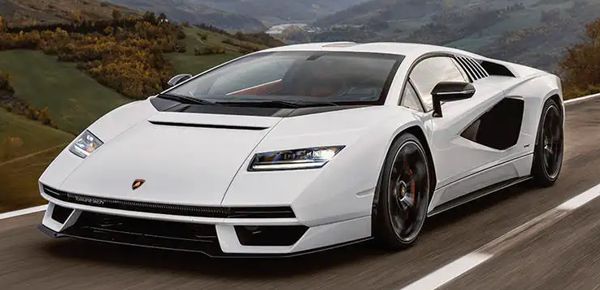
|
|
Ridiculously,
a guy who had never seen a Countach in childhood is responsible for
recreating the “new” Countach.
|
|
Mitja Borkert was born in
1974, the same year as the birth of the production Lamborghini
Countach. Unfortunately, he grew up in East Germany, so he had never
seen the original Countach in his childhood. Many years later, the
reunification of Germany brought him the chance to study automotive
design at Pforzheim, landed him a job at Porsche. Many say Porsche is
not a good place for creative designers. Borkert spent many years
drawing evolutions of existing cars until one day, when Porsche wanted
to explore the possibility of an electric car. Borkert created the
Mission E concept, which eventually became Taycan. For a designer with
such a limited track records in creativity, it is surprising that he
was transferred to Lamborghini and heads the Centro Stile in 2016.
Ridiculously, the guy who had never seen a Countach in childhood is
responsible for recreating the “new” Countach.
The new Countach is not a true successor to the old Countach. It is
just a one-off built on the underpinnings of Aventador, just like the
earlier Centenario and Sian. As the production of Aventador has ended,
Sant’Agata has time and capacity to do a special edition like this.
Lamborghini rarely does retro design, but when the old car they take
reference was the most avant-garde design in the 1970s, why not? Almost
50 years on, Countach is still reckoned as the definitive Lamborghini
with its space-age shape penned by Marcello Gandini. It was the poster
car in the childhood of many billionaires today. By creating a second
incarnation of Countach, Borkert is guaranteed to succeed. It turns out
true, as all 112 cars had been sold well before its announcement, even
though each car costs 2 million euros before tax, or 5 times the
Ultimae Aventador. It is a good way to
earn thick profit, but not necessarily good to the reputation of
Lamborghini.
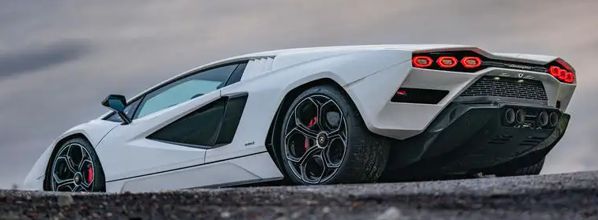
|
|
It
certainly looks like the classic in certain angles, but doesn't in
other.
|
|
Inevitably, the new body has to keep the silhouette of Aventador, as it
is bounded by the same roof line, windscreen and windows. However,
Borkert reshaped its front end like the original car. The sides use
NACA ducts, louvered intakes and hexagonal wheel arches to pay tribute
to the original. The tail design is remarkably close to the original
LP400, too, especially the polygonal space surrounding the taillights,
although the lights themselves come from Sian. That said, fans of the
classic model can still tell a lot of differences. For example, the
lack of pop-up headlamps; The oversized NACA ducts are not real NACA
ducts, just big triangular empty spaces that feed the same size engine
intakes of Aventador; The doors of Aventador are also very different
from Countach’s, whose windows are split and angled towards the sky.
Fans of later Countach may also be disappointed with the lack of
trademark rear wing and extended wheel arches. The new car uses an
active rear spoiler that normally recesses flush above the taillights.
Most important, look at the picture at the bottom of this article, you
will see the original LP400 is so much more beautiful, thanks to
crisper lines, cleaner surfaces, lighter and sharper perception. The
25th Anniversary edition shown in the same picture – which was designed
by Horacio Pagani, by the way – may not be a good comparison, but if
you take just any of the LP400S, LP500S or QV, especially in red, you
will find the old design easily trumps the new one for visual impact.
They are true timeless classic, while the new one is only a poor
attempt to model on the classic, because it has to compromise with the
softer lines and more rational shape of a modern Lambo.
In the mechanical side, it does not move the game on. Powertrain is
recycled from the Sian, which means a 780 hp V12 assisted with a 34 hp
electric motor incorporated in the transmission for a total of 814 hp.
It uses supercapacitor instead of battery to supply the motor, so the
extra power is available in a rather short period. Neither can the car
be powered by electric alone. The gearbox and the chassis are identical
to just about any other Aventadors.
Inside, the cockpit architecture remains the same, but the design of
dashboard, air vents, console and trims are different, especially the
adoption of portrait touchscreen. Brilliantly, Borkert converted the
periscope channel that never worked on the LP400 to a stripe of glass
roof. While it is not exactly panoramic, it runs the full length of the
roof and frees up the ambience. Moreover, the glass is
electrochromatic, thus it can change from transparent to matt with a
click of a button.

|
|
Looking
backward is not the DNA of Lamborghini.
|
|
The original Countach was meant to be the fastest car in the world. The
same cannot be said to this one, even by the standards of Lamborghini
itself. Weighing at 1595 kg without fuel and water, it is just as heavy
as the Sian. No wonder it quotes identical performance, i.e. 221 mph
top speed, 0-60 in 2.7 seconds and 0-124 mph in 8.6 seconds. A Ferrari
SF90 is nearly 2 seconds quicker to 124 mph.
On the road, the ride is curiously harsher than that of the Ultimae.
The extra weight, especially located high at the roof, do it no favour
in handling. The electric power is noticeable only at very low revs
when the engine is not working hard. Otherwise it is the usual
Aventador. 2 million euros buys you not a better Aventador, but a
statement of success.
Perhaps that is why just a few days after the announcement of this car,
the legendary Marcello Gandini released a statement to clarify that he
had no involvement in the new car. Not just that, you can see how
unhappy he was with the philosophy of it:
“I have built my identity as a designer, especially when working on
supercars for Lamborghini, on a unique concept: each new model I would
work on would be an innovation, a breaker, something completely
different from the previous one," he says.
"Courage, the ability to create a break without sticking to the success
of the previous car, the confidence in not wanting to give in to habit
were the very essence of my work. It is clear that markets and
marketing itself has changed a lot since then, but as far as I am
concerned, to repeat a model of the past, represents in my opinion the
negation of the founding principles of my DNA."
Actually, looking backward is not the DNA of Lamborghini either.
|
Verdict:   |
|